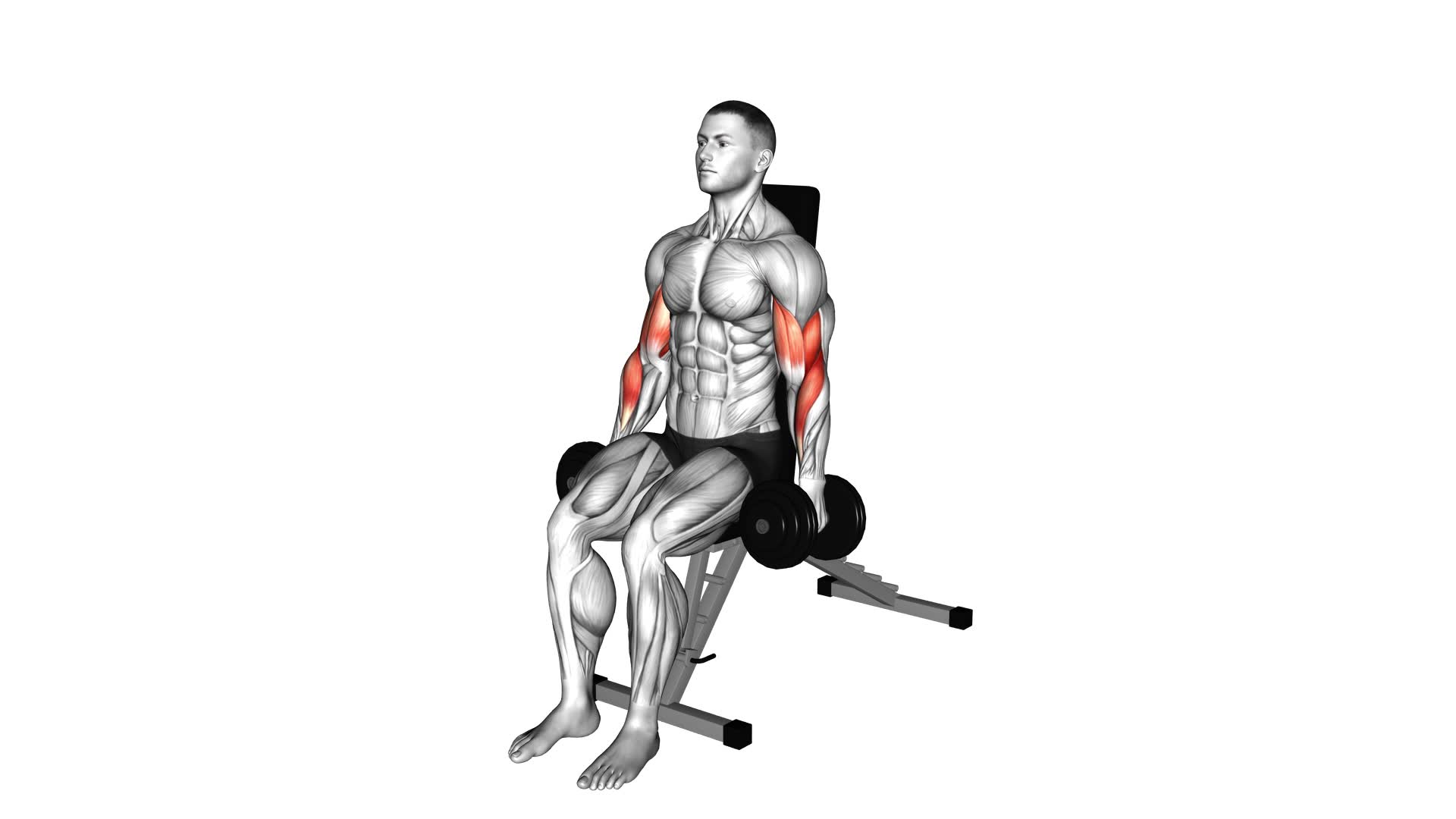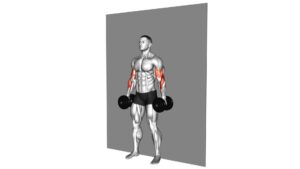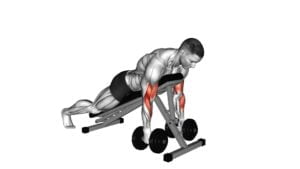Dumbbell Alternate Seated Hammer Curl – Video Exercise Guide & Tips

Looking to tone your arms and build strength? The Dumbbell Alternate Seated Hammer Curl is a must-try exercise. In this video exercise guide, we'll show you the proper form and technique for maximum results.
Watch This Exercise Video
You'll also find helpful tips to make the most out of your workout and avoid common mistakes. Whether you're a beginner or an advanced user, this exercise has variations and progressions to challenge you.
Get ready to sculpt your arms and achieve your fitness goals.
Key Takeaways
- Improved grip strength
- Engages muscles in forearms, wrists, and hands
- Targets different muscle groups compared to traditional bicep curls
- Helps develop a well-rounded arm strength
Benefits of the Dumbbell Alternate Seated Hammer Curl
The dumbbell alternate seated hammer curl offers numerous benefits for your arm muscles and overall strength. One of the key benefits of this exercise is the improved grip strength it provides. Gripping the dumbbells in a hammer-like grip engages the muscles in your forearms, wrists, and hands, helping to strengthen and stabilize these areas. This can be especially beneficial for athletes participating in sports that require a strong grip, such as rock climbing or grappling.
Another benefit of the dumbbell alternate seated hammer curl is that it targets different muscle groups compared to traditional bicep curls. While both exercises primarily work the biceps, the hammer curl also engages the brachialis and brachioradialis muscles in your forearm. This helps to develop a well-rounded arm strength and can contribute to a more balanced physique.
Proper Form and Technique for the Exercise
To perform the dumbbell alternate seated hammer curl correctly, focus on maintaining a stable seated position while curling the dumbbells in a hammer-like grip. This exercise primarily targets the biceps, forearms, and brachialis muscles. To ensure proper form and technique, follow these guidelines.
Firstly, sit on a bench or chair with your back straight and feet flat on the floor. Hold a dumbbell in each hand with a neutral grip, palms facing each other. Keep your elbows close to your sides throughout the movement.
As you lift the dumbbells, exhale and slowly curl one arm at a time towards your shoulders, maintaining control and avoiding any swinging or jerking motions. Keep your wrists straight and squeeze your biceps at the top of the movement.
Common mistakes to avoid include using excessive weight, which can lead to poor form and increased risk of injury. Additionally, avoid leaning back or using momentum to lift the dumbbells, as this reduces the effectiveness of the exercise.
To get the most out of this exercise, focus on maintaining a slow and controlled tempo, ensuring a full range of motion. Aim for 2-3 sets of 10-12 repetitions per arm, gradually increasing the weight as you become stronger.
Tips for Maximizing Your Results
To maximize your results while performing the dumbbell alternate seated hammer curl, follow these tips:
- Maintain proper form: Keep your back straight, shoulders relaxed, and elbows close to your sides. This will ensure that you're targeting the correct muscles and avoiding injury.
- Use appropriate weight: Choose a dumbbell weight that challenges you but still allows you to maintain proper form throughout the exercise. Gradually increase the weight as you become stronger.
- Control your movements: Slowly lift and lower the dumbbells, focusing on the contraction of your biceps. Avoid swinging or using momentum to lift the weight, as this takes away from the effectiveness of the exercise.
- Incorporate nutrition tips: To see optimal results, pair your workouts with a balanced diet. Aim to consume enough protein to support muscle growth and repair. Include a variety of fruits, vegetables, and whole grains for essential nutrients.
To maximize your results, consider incorporating the dumbbell alternate seated hammer curl into a well-rounded workout routine. Include other exercises that target different muscle groups, such as tricep dips, shoulder presses, and bent-over rows. Additionally, make sure to give your muscles time to rest and recover between workouts.
Common Mistakes to Avoid
Avoid these common mistakes to ensure proper form and maximize the effectiveness of your dumbbell alternate seated hammer curl. Proper technique is crucial to prevent injury and get the most out of your workout. Here are some common mistakes to watch out for and technique tips to help you perform this exercise correctly.
One common mistake is using too much weight. It's important to start with a weight that you can comfortably lift and gradually increase as you become stronger. Using excessive weight can compromise your form and lead to injury.
Another mistake is swinging the dumbbells. This often happens when the weight is too heavy or when you're trying to lift more than you can handle. To avoid this, focus on keeping your upper arms stationary and only moving your forearms.
Improper grip can also hinder your progress. Make sure to hold the dumbbells with a neutral grip, meaning your palms face each other. This will engage your forearm muscles more effectively.
Lastly, rushing through the exercise is a common mistake. Take your time and perform the movement slowly and controlled. This will increase the tension on your muscles and maximize the benefits of the exercise.
Variations and Progressions for Advanced Users
How can you challenge yourself and progress with the dumbbell alternate seated hammer curl exercise?
As an advanced user, you can incorporate various techniques and strategies to take your workout to the next level. Here are some advanced variations and progressions to consider:
- Increase the weight: Gradually increase the weight of the dumbbells to challenge your muscles and promote growth.
- Add resistance bands: Incorporating resistance bands adds extra tension throughout the movement, further engaging your muscles.
- Try eccentric training: Focus on the eccentric phase of the exercise by slowing down the lowering of the dumbbell. This can enhance muscle strength and hypertrophy.
- Perform drop sets: After completing a set with a challenging weight, immediately switch to a lighter weight and continue the exercise until failure. This technique helps to increase muscle endurance and promote muscle growth.
Frequently Asked Questions
Can the Dumbbell Alternate Seated Hammer Curl Help With Building Forearm Strength?
Yes, the dumbbell alternate seated hammer curl can definitely help you build forearm strength. By performing this exercise, you engage the muscles in your forearms as you curl the dumbbells up towards your shoulders.
This exercise targets the brachioradialis, which is responsible for flexing the forearm.
Additionally, there are variations of the dumbbell alternate seated hammer curl that you can incorporate into your workout routine to challenge yourself at different fitness levels.
How Heavy Should the Dumbbells Be for Beginners?
For beginners, it's important to start with lighter dumbbells to avoid straining your muscles. Gradually increase the weight as you get stronger.
The dumbbell alternate seated hammer curl is a great exercise for building forearm strength and overall arm development. By using dumbbells, you engage more muscles and improve grip strength.
Regularly performing this exercise can lead to stronger forearms, increased muscle definition, and improved performance in other exercises.
Is It Necessary to Warm up Before Performing the Dumbbell Alternate Seated Hammer Curl?
Before performing the dumbbell alternate seated hammer curl, it's necessary to warm up your muscles. Stretching can help prevent injuries and improve your performance.
Additionally, there are precautions you should take while performing this exercise. Maintain proper form, avoid excessive swinging, and start with lighter weights if you're a beginner.
These measures will ensure that you get the most out of your workout while minimizing the risk of injury.
Can This Exercise Be Modified for Individuals With Wrist Injuries?
If you have wrist injuries, you may need to modify the dumbbell alternate seated hammer curl exercise. It's important to prioritize your safety and avoid aggravating your condition.
However, hammer curls can still benefit your overall arm strength. By using lighter weights or resistance bands, you can perform modified exercises that put less strain on your wrists while still targeting your biceps and forearms.
Consult with a professional trainer or therapist for personalized modifications.
How Often Should the Dumbbell Alternate Seated Hammer Curl Be Performed for Optimal Results?
To get optimal results, how often should you do dumbbell alternate seated hammer curls?
Incorporating this exercise into your workout routine can provide several benefits, such as targeting your biceps and forearms, improving grip strength, and promoting muscle balance.
However, it's important to avoid common mistakes like using momentum or lifting too heavy.
Aim for 2-3 sets of 8-12 reps, 2-3 times per week.
This frequency will give your muscles enough time to recover and grow.
Conclusion
In conclusion, the dumbbell alternate seated hammer curl is a highly effective exercise for targeting the biceps and forearm muscles. By maintaining proper form and technique, you can maximize your results and avoid common mistakes.
Additionally, advanced users can explore variations and progressions to challenge themselves further. Incorporating this exercise into your routine will help you build strength and definition in your upper body.

Author
Years ago, the spark of my life’s passion ignited in my mind the moment I stepped into the local gym for the first time. The inaugural bead of perspiration, the initial endeavor, the very first surge of endorphins, and a sense of pride that washed over me post-workout marked the beginning of my deep-seated interest in strength sports, fitness, and sports nutrition. This very curiosity blossomed rapidly into a profound fascination, propelling me to earn a Master’s degree in Physical Education from the Academy of Physical Education in Krakow, followed by a Sports Manager diploma from the Jagiellonian University. My journey of growth led me to gain more specialized qualifications, such as being a certified personal trainer with a focus on sports dietetics, a lifeguard, and an instructor for wellness and corrective gymnastics. Theoretical knowledge paired seamlessly with practical experience, reinforcing my belief that the transformation of individuals under my guidance was also a reflection of my personal growth. This belief holds true even today. Each day, I strive to push the boundaries and explore new realms. These realms gently elevate me to greater heights. The unique combination of passion for my field and the continuous quest for growth fuels my drive to break new ground.







